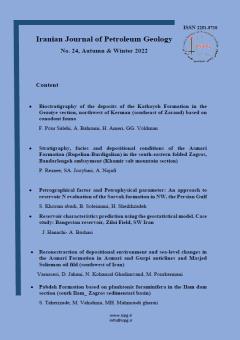One of the most important stages in the hydrocarbon reservoirs morphology is the identification of rocky type. In order to construct an efficient and correct model of a hydrocarbon reservoir, identification of rock types is one of the essential parameters in reservoir m
More
One of the most important stages in the hydrocarbon reservoirs morphology is the identification of rocky type. In order to construct an efficient and correct model of a hydrocarbon reservoir, identification of rock types is one of the essential parameters in reservoir modeling. and its consequences are found in the identification of rock types. The aim of this study is to compare different methods of determining rocky type and understanding the hydraulic flow unit distributions in order to assess the quality of reservoir of Razak Formation with sandstone carbonate lithology, marl and anhydrite to San Oligocene to lower Miocene. In this research, the experimental results of porosity, permeability and capillary pressure curves for 84 samples with porous microscopic sections Related to a 46-meter drill bit in one of the important fields of southeast of Iran were analyzed. The petrographic studies were conducted to investigate the changes of the features in the reservoir section with Razak formation and resulted in the identification of eight microfeatures( The MF1 packstone and Wackstone are at a depth of 2829 meters- The MF2 is the grinstone packstone at a depth of 2844 meters-the MF3 is the wackstone mudstone at a depth 2856 meters-the MF4 is the grinstone at a depth 2859meters –the MF5 is the mudstone wackstone are at a depth2848 meters – the MF6 mudstone at a depth of 2838 meters the MF7is the wackstone mudstone at a depth 2840 meters- The MF8 is a wackstone with sandstone depth of 2831) meters- in open Marin lagoon and fluvial clastic systems. In order to determine the rocky species and assess the flow units based on the core analysis results, four petrophysical classes were identified using the Lucia method. The petrophysical category number 1 has the best reservoir quality and the fourth category has the weakest reservoir quality. Also, the flow units were identified and separated using Amalufee and Lorenz's methods. Based on the Amalufee method, in the reservoir section of the Razak Formation, seven flow units have been identified, the sixth and seventh stream units were the best and one was the weakest reservoir segments among the seven units of the flow. Also, based on the analysis of capillary curves, six rocky species were distinguished, based on which the rocky type number five and six have the best quality. Also, using Geology software cross-sections, it was revealed that the main part of this section is sandstone with clay. The presence of gas in the formation causes cross-sectional deformation of samples to the northwest cross-platform. Finally, with the combination of various data, it was found the fossil formation in the study area has five types of rock in which the number 4 rock has the best quality of reservoir and rock number 5 has the largest reservoir and the unit number six is the best.
Manuscript profile


